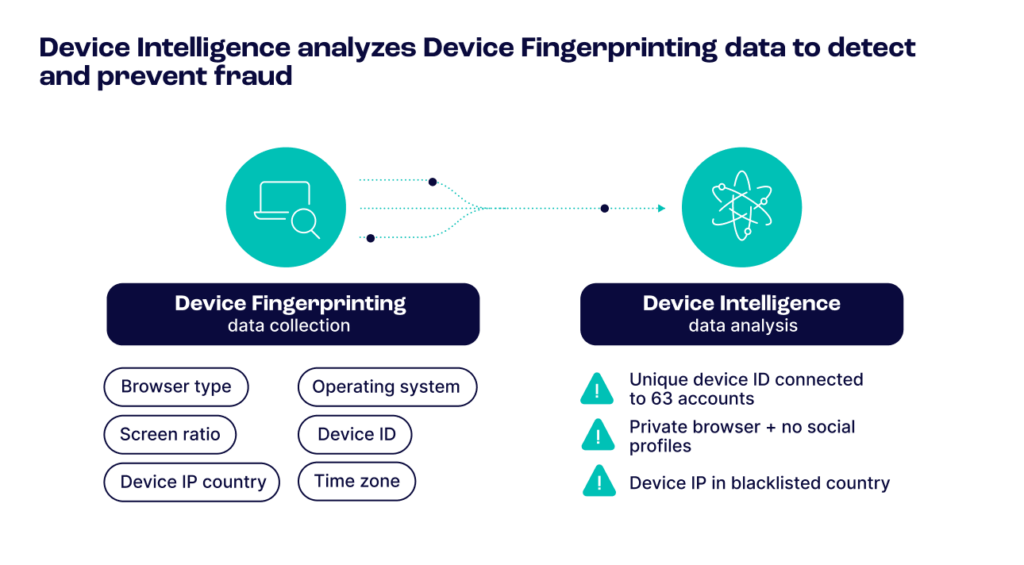A heightened complexity of fraud tactics marks the fraud ecosystem. Fueled by technology advancements and the widespread availability of affordable cloud computing, this evolution has democratized the ability to launch large-scale cyberattacks and fraud schemes, enabling virtually anyone to orchestrate them.
The rise of generative AI is a double-edged sword, yielding significant productivity benefits while empowering fraudsters to craft more intricate and convincing scams at unprecedented volumes and velocities. With new tools like private browsing, VPNs and anti-tracking settings to further complicate the prevention and detection of fraud, bad actors are more adept than ever at concealing their identities and intentions online.
What is Device Intelligence?
Device intelligence represents a cutting-edge anti-fraud approach that analyzes thousands of real-time data points to detect and prevent fraud, including scrutinizing hardware and software configurations across desktop and mobile devices and user behaviors to uncover patterns indicative of fraudulent activities. Device intelligence also enables the continuous monitoring and dynamic analysis of data points to safeguard online transactions and interactions.

Device Intelligence Vs. Device Fingerprinting
Device intelligence and device fingerprinting are integral components in the ongoing battle against online deception and fraudulent activities. Device fingerprinting is the process of generating unique identifiers for individual devices based on various attributes and configurations. These identifiers serve as a means of distinguishing one device from another within a network or ecosystem.
On the other hand, device intelligence expands beyond mere identification to encompass a comprehensive analysis that examines user behaviors, usage patterns and device interactions to gain deeper insights and understand risk profiles. While device fingerprinting creates identifiers for devices, device intelligence utilizes these identifiers and other data sources to identify standard device setups to fraudsters’ tool stacks and facilitate better anti-fraud decision-making.
Use device intelligence for a proactive defense against the most sophisticated fraud schemes.
Speak with an Expert
How Does Device Intelligence Work
When a user accesses a platform, such as their account at an ecommerce retailer, social media, online banking or bill pay service, it is either through a device with a mobile application or a desktop computer with an internet connection that retrieves an IP address. This creates two data sources that are present at signup, login, checkout or during browsing sessions. Since each user’s configurations are analyzed, a unique ID – either a cookie hash, device hash or browser hash – is created to recognize existing connections between users and devices and to highlight suspicious devices.
Example parameters that can be examined for information include:
- Device Identification: device hash, browser hash, cookie hash, device UDID/ADID
- Device Status: on call, screen mirroring, screen captured, audio status
- Device Safety: device biometrics, passcode enabled, remote control enabled
- Location: geolocation, region country, timezone identifier, city and zip code
- Network: VPN usage, device IP, cellular or Wifi data configuration
- User Preferences: keyboard layout, incognito, cookies disabled
- Display Configurations: device orientation, screen resolution, device language, window size
- Software Environment: browser type & version, web RTC activated, adblock, plugins
- Hardware Environment: device type, operating system, emulator detection, rooted device.
By using thousands of real-time device signals, from geolocation and IP information to behavioral data such as battery life, phone orientation and font count, suspicious setups and settings across desktop and mobile devices can be flagged and blocked.
Five Use Cases for Leveraging Device Intelligence to Fight Fraud
To illustrate how device intelligence works, let’s look at five compelling use cases that showcase its power to safeguard businesses and users alike:
1. For Bonus & Promo Abuse Detection
Leveraging device intelligence enables the accurate identification of legitimate customers versus potential abusers. You can effectively eliminate promo and bonus abuse by analyzing cookie, device and password-sharing patterns and detecting attempts to manipulate data using privacy tools.
2. Multi-Accounting Detection
Through meticulous tracking of device and browser IDs associated with each user account, device intelligence facilitates the detection of multiple users accessing your platform from the same device, enabling proactive measures to preserve the integrity of your user base.
3. Account Takeover Prevention
Device intelligence is a robust defense mechanism against unauthorized access by identifying unfamiliar devices or browsers attempting to log in. Additionally, it can swiftly detect suspicious emulators or virtual machines frequently utilized by fraudsters in account takeover schemes and phishing attempts to trick users into revealing their login credentials. This is where you can integrate new real-time detection triggers, such as if a fraudster is accessing your customer’s account remotely, if your customer is sharing their screen sharing with a fraudster, and understanding if the customer is on the phone with the fraudster while making changes to their account.
4. Chargeback & Friendly Fraud Prevention
Combining device intelligence with digital footprinting strengthens identity verification processes and aids in discerning customers’ genuine intentions. This proactive approach deters chargebacks by enabling companies to collect extensive data – including software and hardware configurations and user behavior patterns, such as transactions made from a customer’s usual device, through their common IP address, using their typical browser, and at their normal transaction times – to contest chargebacks effectively. Such detailed evidence supports a strong narrative to challenge fraudulent chargebacks and supports how companies respond to friendly fraud or chargeback attempts, safeguarding against financial losses.
5. Bot Attack Mitigation
Device intelligence offers comprehensive insights into user environments by scrutinizing installed plugins, browser versions, window sizes, screen resolutions and more. Additionally, it efficiently identifies emulators and virtual machines, facilitating effective bot management strategies to thwart malicious attacks on your platform. This is where you can integrate residential proxy detection to bolster bot attack mitigation.

Enhanced Fraud Prevention Capabilities
Modern fraud detection solutions can now discern if someone is remotely accessing a customer’s device, such as through screen sharing on mobile and web apps. These systems can further identify apps capable of interfering with or altering other applications on Android platforms. Another crucial aspect is on-call monitoring, particularly relevant for iOS and Android users, where the system can determine the call status of a customer. This feature is invaluable in detecting phishing scams, especially in the financial service industry. Understanding the type of carrier, whether it’s a primary provider like AT&T, T-Mobile or Verizon versus a VoIP service, aids in distinguishing legitimate user activity from fraudulent attempts.
Additionally, residential proxy detection plays a vital role in verifying user locations and identifying suspicious attempts to access restricted services or manipulate IP addresses. These advanced capabilities collectively enhance fraud detection measures, ensuring heightened security and protection against evolving threats.
Leverage cutting-edge device intelligence to identify fraud in real-time
Speak with an Expert
Future-Proofing Fraud Prevention
Operating with real-time, unparalleled information, device intelligence reaches beyond traditional methods like multi-factor authentication or security questions. By connecting the dots through a vast array of data points, ranging from geolocation and IP information to more nuanced behavioral device data like battery life, phone orientation and font count, device intelligence offers a comprehensive view of a user and relevant user interactions.
Through scrutinizing thousands of device signals, it can swiftly identify deviations from typical user patterns. Whether detecting sudden changes in geolocation, unusual IP addresses, or discrepancies in device configurations, device intelligence is a vigilant guardian against fraudulent attempts, serving as a dynamic and proactive defense mechanism in the fight against online fraud.








